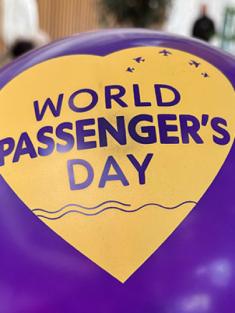A Magical Christmas at Nice Côte d’Azur Airport
This year, the magic of Christmas comes to the terminals to delight young and old alike. Let yourself be carried away by the festive spirit.
Published on 18-01-22
Despite stringent health measures and travel restrictions, Nice Côte d’Azur Airport is ending 2021 with a higher traffic than expected – 6.54 million passengers – helped by the return of long-haul flights from the summer season. At the same time, and in accordance with its commitments, the airport has continued its efforts to reduce its greenhouse gas emissions, gaining highest level of Airport Carbon Accreditation, level 4+.
The year 2021, even though made special by the persisting COVID-19 pandemic, will have benefited from the numerous investments made by the Nice Côte d’Azur Airport to position itself as the airport of the future: an ultra-efficient airport which is completely safe from a health standpoint, and a leader in its commitment to reducing its environmental impact.
After a first year of the pandemic, the airport has also been able to regain some traction, welcoming 6.54 million passengers in commercial traffic, a recovery rate of 45% compared to 2019's reference. This average growth masks the disparity between the first semester, which was very affected by the lockdown measures and only saw an average recovery rate of 23%, and the second semester, which was much more positive and saw an average recovery rate of 64% compared to 2019. Though the traffic is still largely focused on domestic routes (69% recovery rate) and Schengen routes (39.8%), international traffic has had a proactive return, with close to a quarter of traffic returning, primarily concentrated in the second semester.
“This recovery of passenger traffic, and more specifically of long-haul flights, attests to how attractive our region is, and to the airlines’ and passengers’ confidence in the health safety measures that have been implemented, and allows us to be optimistic for the year to come, as we already have a large number of destinations – particularly transatlantic ones – in our provisional flight programme for the 2022 summer season” summarises Franck Goldnadel, Chairman of the Board of Aéroports de la Côte d’Azur
This progressive recovery of air traffic is in line with the airport’s strategy to promote low-carbon aviation. First and foremost through an ambitious policy on its own emissions, as the airport – which has already been carbon neutral since 2016 – gained in 2021 the highest level of Airport Carbon Accreditation, level 4+. This accreditation certifies that the airport has succeeded in reducing its emissions in a definite way (-4.4%), that it has quantified semi-cruising aircraft emissions and integrated this volume into its reduction and compensation plan, but also that it has committed to absorb CO2 with plant-based carbon sinks near its terminals. Along with Cannes Mandelieu and Golfe de Saint-Tropez, these three airports of the Aéroports de la Côte d'Azur group are now the only ones in France to have received this accreditation.
“Receiving the level 4+ Airport Carbon Accreditation isn’t a greenwashing operation. It represents the factual and international recognition of a sincere commitment and an ambitious and unprecedented action plan. When we reduce the absolute value of our direct emissions, we help to protect our region. This involves taking numerous actions, being innovative and looking for solutions that help to reconcile air transport with air quality requirements on a daily basis. In the future, low-emission aeroplanes will take off and land on totally neutral airports. This is the course of history, and we want to be the leading laboratory in this field,” explains Franck Goldnadel.
Among the latest innovations implemented by the airport to reduce its carbon footprint, removing the gas heating in terminal 1 and replacing it in autumn 2021 with a temperature water loop whose energy stems from the Métropole’s wastewater network, representing 700 tonnes CO2 saved per year.
In addition to the actions undertaken by its facilities, the airport supports the development of the aviation of the future. In September, a scheduled commercial flight from AirFrance connecting Nice to Paris took to the air with 30% biofuel or Sustainable Aviation Fuel –a first at this level. A few days earlier, HSH Prince Albert II of Monaco achieved the first fully electric flight of a head of state, on board a Pipistrel Velis Electro having taken off from the Nice airport. This same plane was then presented at the Cannes airport’s flying clubs and training centre, to demonstrate how relevant it could be to include this aircraft into their fleets. “The electric plane is suited to this kind of structure and we are going to do all we can for its popularisation, through the reduction of airport fees and grants covering the purchase. The electric plane means zero-emission and reduced noise in flight. We owe it to our region,” explains Franck Goldnadel.
Finally, the last project to be set up in 2021: Urban Blue works to design and implement the necessary infrastructures for developing e-Vtols, electric drones that are able to transport passengers without energy from fossil fuels. The seafront location of the Nice Côte d’Azur, and Cannes-Mandelieu airports helps with experimental phases, as well as the saturation of the region’s ground infrastructures warranting the emergence of a complementary transport offer.
Through their resilient nature, as well as the region’s attractiveness, which allows for medical evacuations and offers an alternative to essential travel in periods of low commercial traffic, business aviation has regained its pre-pandemic levels in the three Côte d’Azur airports. The traffic of 2021 in numbers:
- Nice Côte d’Azur : 37,000 business aviation
- Cannes-Mandelieu : 13,000 business aviation
- Golfe de Saint-Tropez : 3,700 business aviation

This year, the magic of Christmas comes to the terminals to delight young and old alike. Let yourself be carried away by the festive spirit.

For this, the third annual event, a record number of airports will be getting involved in World Passenger Day, on 17 November 2025, with events and fun activities especially for travellers.

Find the best deals from shops and restaurants in the shopping cheque book available in the departure lounge of your favourite airport.